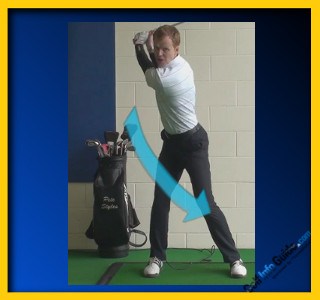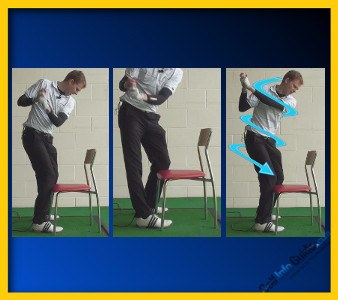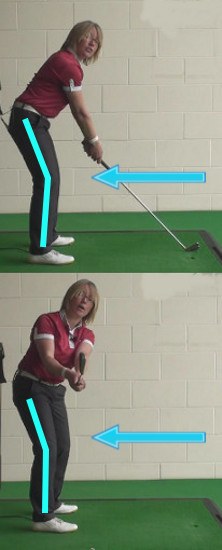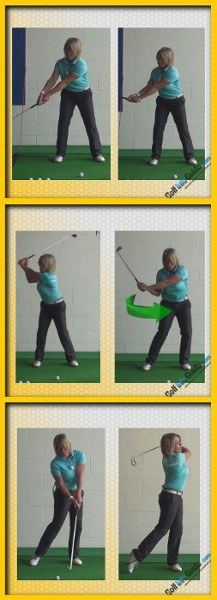
Sometimes, talented young golfers turn pro too early and flame out. Other times, it just takes them a while to find their footing and fulfill their potential.
Justin Rose has lived both ends of the spectrum.
Fresh off a fourth-place finish at the 1998 Open Championship at age 17, the Englishman joined the European Tour. Twenty-one consecutive missed cuts later, it appeared he'd made a big mistake. But Rose hung tough, breaking through with a pair of wins in 2002. He steadily climbed the world rankings over the next 10 seasons, winning a handful of PGA Tour events and establishing himself as one of the game's most consistent players.
Rose took the next step by winning the 2013 U.S. Open at Merion. His first major victory vaulted Rose to No. 3 worldwide and showed the value of patience. A little talent helps, too. Make that a lot of talent.
Rose has been through several teachers along the way. Early on he worked with David Leadbetter as well as his father, Ken, who passed away in 2002. In 2006 Rose hired Nick Bradley before jumping to an upstart named Sean Foley in 2009. (Foley's fame would skyrocket the next year when he became Tiger Woods' coach.)

No matter who has coached him, Rose's swing has always reflected a devotion to fundamentals every golfer would be wise to emulate.
Rose's signature: He maintains the flex in his right knee throughout the backswing.
Who else does it: Nearly all top-notch golfers, including Ernie Els and Adam Scott.
What it looks like: In all honesty, Rose displays any number of fundamentally pure moves that could be considered his signature. We chose to focus on his right knee because so many amateurs struggle with this seemingly simple concept.
With his knees flexed in an athletic address position, Rose shows excellent balance. As his hips rotate, the right knee stays bent rather than straightening. At the top of the swing, he's loaded a majority of his weight onto the right side without tipping onto the outer edge of his right foot. In fact, the inner foot bears most of this burden as Rose remains centered over the ball – and coiled for a powerful downswing.

Why it works for Rose: In conjunction with his excellent fundamentals, Rose's consistent knee flex allows him to remain beautifully balanced with his posture intact. It also enables his hips to turn with great speed into the shot.
How it can work for you: If the right leg straightens as you turn away from the ball, the hips are restricted and you lose power. Same thing if the knee buckles outward and your right instep comes off the ground.
If you struggle to use the knees properly during the swing, here's a video tip that will help straighten things out… so to speak:

Justin Rose Right Knee Stays Flexed for Balance, Power
As far as a career in the game of golf goes, it is hard to do much better than Justin Rose. While Rose should still have many productive and lucrative years in front of him, his career would already Hall of Fame worthy without another accomplishment. To this point, Rose has one career major title – the 2013 U.S. Open – along with an Olympic Gold Medal. He has also finished within the top four of all the other majors at least once, and he has been ranked as high as 3rd in the world. Any way you look at it, Justin Rose is one of the best golfers on the entire planet.
Of course, it takes a wide range of skills to have as much success on the course as Rose has enjoyed throughout his career. Obviously, you have to have a solid golf swing. You also have to have an excellent touch on and around the greens, and you need a steady nerve under pressure as well. Golfers who play at this level also need the right attitude, and rose is known for his hard-working, positive nature. While his professional career didn't actually get off to a great start – he missed his first 21 cuts as a pro – he stuck with it and developed into a world-class player.
While Justin Rose certainly has a wide range of skills that he calls on to perform at the highest level, we are going to look at just one very specific part of his technique in this article. One of the great things that Rose does in his swing is keep the right knee flexed throughout the action. This is a point that gives many amateur golfers trouble, but it is highly important if you would like to take a step forward in your game. There is a lot to be gained when you keep that right knee flexed, which is a point that is not lost on Justin Rose. He doesn't make this move by accident, but rather he keeps his knee flexed because he knows how helpful it will be to his performance overall.
You probably aren't going to play at the same level as Justin Rose anytime soon, and your swing probably won't look much like his, either. However, if you are willing to work on the positioning of your right knee during the swing, you can make progress in terms of improved ball striking. It doesn't take any specific talent to put your right knee in the correct position – it just takes attention to detail and plenty of practice. Hopefully, by the end of this article, you will have all of the motivation and instruction you need to integrate the flexed right knee into your golf swing.
All of the content below is written from the perspective of a right-handed golfer. If you play left-handed, please take a moment to reverse the directions as necessary.

So Much to Gain
It might not seem like something as simple as the position of your right knee could have a powerful impact on your game, but it can. If you do a good job of holding your right knee in a flexed position throughout the swing – just like Justin Rose – you can look forward to being rewarded with improved play almost immediately. The list below includes a number of the ways in which you can benefit from sticking with this swing fundamental.
- Ball striking consistency. If there is one thing that all golfers would love to have more of on the course, it's consistency. Sure, it would be fun to have more distance or a higher ball flight, but if you think about it, the thing holding you back is really consistency. If you could repeat your swing time after time, your results would improve dramatically – even if you aren't the most powerful player on the links. By flexing your right knee at address, and then holding that flex throughout the swing, you should be able to dramatically improve the consistency of your strike. Since there won't be as much movement in your body as there would be if you let that knee move around, you will be able to deliver the club to the ball the same way over and over again. Simplicity is a great thing in golf, as simplicity leads directly to consistency.
- Development of power. While power is not as important on the course as consistency, it still is a very important trait to possess. If you can hit long drives off the tee, for example, you are going to set up shorter approach shots all day long. And it should go without saying that shorter approach shots are usually going to lead to shorter birdie putts. Holding your right knee in a flexed position is going to set you up for a powerful backswing by making sure you are poised to strike from the top of the swing. If that leg straightens, you are going to give away some of your potential power, and your swing will always fall short of its capability. Nearly all of the long hitters in the professional ranks keep their back leg flexed during the backswing, and you should be doing the same.
- Excellent balance. The matter of balance can be rolled into consistency as you aren't going to have one without the other. You should already know that balance is a critical piece of the golf puzzle, even if you don't focus on it as much as you should. By utilizing your right knee correctly, you won't need to think too hard about balance because your balance should be naturally on track thanks to the good work you are doing with your right leg. Players who have poor balance often drift away from the target during the backswing, so your right leg needs to play a key role in preventing that from taking place. Keep yourself balanced between your two feet as effectively as possible to ensure that you can strike down on the ball without any variation from swing to swing.
- Translation into the short game. This might not be a point you would think of right away when working on your full swing, but improving your performance in this area can actually help you to perform better in the short game as well. Stability is one of the leading keys in the short game, and your right knee can be your best friend while trying to stay still over your putts and chip shots. Set up to your short game shots with plenty of knee flex and then hold that flex perfectly steady as the club rocks back and through. The ability to improve your short game while working on your full swing is exciting, and it means that you can get even more benefit from the time you invest on this tip.
As a professional golfer playing for millions of dollars week in and week out, you can bet that Justin Rose pays attention to every little detail in his swing. His right knee is no remaining steady and flexed just by accident – it is behaving that way because he has determined that this technique is best for his swing. Once you give it a try for yourself, it is likely that you will agree. It may take a bit of practice to get comfortable with this technique, but you should see progress relatively soon once you get started.

Getting Comfortable
From an instruction perspective, there isn't much to say about this point as you get started. You need to flex your knees when you address the ball, and you need to keep them flexed while swinging up to the top of the backswing. That's it. There really isn't anything more to it than that, so it is up to you to head out and practice this kind of swing. Golf instruction can only take you so far before it is your turn to take over and figure the rest out for yourself.
With that said, we can help you navigate some of the problems areas which are likely to pop up along the way. This kind of swing is not going to be comfortable at first if you are used to swinging with a straight right leg. Should you notice that you are having trouble settling in to this swing, review the tips below for help.
- Take your time going back. Letting your right knee straighten during the backswing will allow you to make a quicker move going back – but that is not necessarily a good thing. A deliberate backswing will often lead to a powerful downswing, so take your time and don't feel like you have to rush through the action. Remember, the only point during the swing where the club needs to be moving quickly is at the bottom. Other than that, you are free to take your time and move slowly. Focus on making a controlled backswing while your right knee stays perfectly still. It might help to hit some soft wedge shots when first learning this technique before you move on to bigger swings with longer clubs.
- Turn your right foot open slightly. Part of the challenge you will find with keeping your right knee flexed is that this technique is going to ask more of your flexibility. When you let your right knee straighten, it is easier to get all the way back into a full backswing. So, to counteract that adjustment, one thing you can do is to open your right foot slight at address. Keep your heel in place and turn your toes out just a few degrees to make it easier to turn away from the ball. This is going to naturally make your backswing a bit longer without requiring you to improve on your overall flexibility. If you do manage to improve your body's flexibility down the line, you can always turn your foot back into a square position if you so choose.
- Don't force a long backswing. Staying on the topic of flexibility, it is important to note that you don't necessarily need a huge turn in order to hit solid, powerful shots. There are plenty of players on the PGA Tour who hit the ball hard without actually turning all that far. Of course, the one thing that all of those players have is great timing. You need a smooth, reliable rhythm to your swing if you are going to hit quality shots, no matter how long your backswing happens to be. Don't fall into the trap of thinking that you need an exaggerated turn to be a good player – that simply isn't true.
The three tips listed above should go a long way toward helping you get comfortable with the technique of keeping your right knee stable and flexed in the backswing. Of course, simply reading some tips online is not going to automatically make you a better player. You will need to put these ideas into action for yourself if you hope to see any benefit. Try to plan out some practice time in the coming weeks where you can specifically work on the goal of keeping your right knee flexed and steady while you swing.

Taking Advantage
If you manage to get all the way to the top of the backswing with your right knee still flexed and stable, you will be off to a great start. That doesn't mean that the job is done, however. You still need to make a quality downswing, and you have to make sure that downswing takes advantage of what you have accomplished earlier in your motion. A poor downswing will completely waste what you have done up until this point, and that would be a shame.
To take advantage of your solid right knee position, you need to fire your lower body through the shot with confidence. This lower body action needs to lead the way, getting out in front of your upper body on the way down. Once your lower body has turned through aggressively, your upper body – and the club – can follow suit. It is the chain reaction of events described here which will lead to the most powerful and accurate shots of your life.
Sadly, many golfers go wrong by using their hands to lead the way in the downswing. If you make this mistake, it won't matter that you held your right knee firm on the way back, because you will still be making a weak move down into the ball. The whole point of keeping your right knee solid is to then generate a strong downswing where you gradually build power right up until the moment of impact.
To avoid wasting your power during the downswing, consider using the following drill. On the range, take some practice swings without actually hitting a golf ball. During these swings, you are going to swing up to the top of your backswing and pause for a few seconds. Hold your position as still as you can, and make sure you feel balanced from side to side. After holding your top-of-backswing position for a bit, go ahead and start down by firing your left hip open quickly. By breaking up the backswing and the downswing with a pause, you will be better able to feel how this part of the swing is supposed to develop. After a few practice swings, you can gradually reduce the length of your pause until you are back to making normal swings and hitting balls again.
Once the downswing has started correctly, the only thing remaining to do is just hold on for the ride. You have fired your lower body properly, and it is now turning toward the target at a high rate of speed. The club is lagging behind your hands, and your eyes are down on the ball. Everything is going well, but you have to keep your nerve up in order to swing through with confidence and conviction. If you get tentative now, the entire swing can still go wrong. Trust yourself and the preparations you have made, and swing through to a full and balanced finish. As long as you didn't hold anything back, there is a good chance that you will be able to look up and see the ball sailing toward the target in the distance.

Making It Count in the Short Game
As mentioned above, keeping your right knee flexed and stable is crucial not only in the long game, but in the short game as well. Of course, Justin Rose is no stranger to a great short game, as it is impossible to play at his high level without impressive skills both on and around the green. Making progress with your golf swing is great, but you will really start to shoot lower scores when you make strides in the short game. Keep an eye on how your right knee is behaving when you play short game shots and you will start to find the target more often than ever before.
When putting, the role of your right knee is very simple – it shouldn't move at all. Once you get set in your stance with your knees flexed, that right knee (and your left knee) should stay as completely still as possible from start to finish. You want to make as much movement out of your stroke as possible when putting, and one of the best ways to do that is to make sure your knees aren't moving at all. When your knees stay steady, the rest of your body tends to do the same.
The only exception to this rule is when you are playing a particularly long putt across the green. If you need to hit a putt exceptionally hard to actually reach the hole, it may be necessary to let your knees move a little bit just to get enough swing into the putter. That is the only exception, however, so you should be working hard to keep your knees still on all other putts. If you are having trouble with your putting stroke, focusing on the right knee is actually a great way to get back on track. Thinking just about the right knee will help to calm your mind on the greens, and the stroke should just flow naturally while you keep your lower body steady.
The story is going to be largely the same when you are chipping the golf ball from around the greens. You still want to set up with a flexed and firm right knee, and you want to keep that knee mostly steady as you chip. However, it is okay for the right knee to move in toward the left knee a bit during the downswing, especially on longer pitch shots. This action will help give some rhythm to your chipping motion, and it may help you to hit down on the ball properly as well.
If you find yourself stepping off of the grass and down into a bunker, you are still going to need to use your right knee properly. In this case, you will want to add even more flex to your knees, and you are going to stay quite steady again – much like you did on the putting green, in fact. Stability in your lower body is crucial with regard to the sand game because keeping your knees in place will let the club release cleanly through the sand and under the ball.
Justin Rose is one of the truly elite players in the game of golf, and keeping the right knee steady is one of the obvious positives in his swing. You don't have to be an aspiring tour pro to benefit from this concept, as it can help even the average weekend player. Use the tips in this article to focus on this important fundamental during an upcoming practice session. Good luck!





